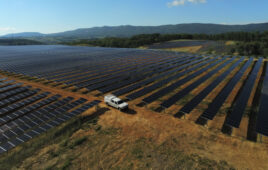By Dave Feitl, VP Global Roofing and Western USA SPF Sales, Huntsman Building Solutions
As the move toward both energy independence and the decarbonization of buildings pushes forward, builders, contractors and owners of commercial structures are all looking for effective ways to optimize their facilities. Not only are environmental impacts top of mind, but so too are energy savings, resilience and, ultimately, return on investment. Materials and systems providing durability and energy solutions are increasingly sought for application in commercial structures. Zero net energy (ZNE), a key movement in North America advocating for both new and retrofit buildings to generate as much (or more) renewable energy onsite as they consume, leverages and showcases ideal solutions for both. Two systems now commonly joined on the roof of commercial structures are solar panels and spray polyurethane foam roofing, the former generating power and the latter providing a resilient and energy-conserving roofing solution. Together, the two offer an energy solution that helps enable zero net energy, yet provides incredible benefits to all other non-ZNE structures as well.
Spray Foam Roofing
 Spray polyurethane foam (SPF) roofing is ideal for a wide range of commercial, agricultural, industrial and residential applications. The material is a high-density, rigid and closed-cell spray foam variety that may be applied over most new and retrofit roofing substrates. It may also be utilized when the roof deck is of an unusual configuration or shape or when a sloped application is required to provide controlled drainage (in addition to being ideal for flat roofs of regular shapes). In roofing, SPF uniquely acts as a protective roofing layer, as well as a thermal insulator, air barrier, vapor retarder and a waterproofing solution.
Spray polyurethane foam (SPF) roofing is ideal for a wide range of commercial, agricultural, industrial and residential applications. The material is a high-density, rigid and closed-cell spray foam variety that may be applied over most new and retrofit roofing substrates. It may also be utilized when the roof deck is of an unusual configuration or shape or when a sloped application is required to provide controlled drainage (in addition to being ideal for flat roofs of regular shapes). In roofing, SPF uniquely acts as a protective roofing layer, as well as a thermal insulator, air barrier, vapor retarder and a waterproofing solution.
The cost-efficient system is professionally spray-applied and locks every portion of the roof into place. Creating a monolithic membrane atop the building, spray foam roofing eliminates the need for mechanical fasteners. The durable material is lightweight yet offers a compressive strength of 40 to 60 pounds per inch. Considered a low-maintenance roof option, it protects the structure from water intrusion, hail and wind uplift, acting as a storm-resistant construction material. Equally important, it prevents heat transfer through the roof deck, minimizes the escape of conditioned air and, in turn, dramatically reduces energy bills for the life of the roof, which can extend to 50 or more years with proper roof maintenance and care. Spray foam roofing, as well as its sister, spray foam insulation, are increasingly utilized in ZNE structures because of their seamless insulating and sealing capabilities.
A Net-Zero Solution
The ZNE movement continues to gain momentum in North America. Zero net energy may be achieved with new, ground-up construction as well as with facility retrofits. A ZNE structure benefits both the owner and the end-user with a building that creates and saves its own energy, decreases energy costs, eliminates fossil fuel dependence and reduces its emissions and environmental footprint.
For obvious reasons, solar PV systems are commonly associated with ZNE structures. Spray polyurethane foam is also gaining a strong reputation as an ideal ZNE solution. In zero-net-energy buildings, exceptional insulation and air-sealing throughout the building envelope, including the roof, are paramount. Spray foam provides both. Thus, spray foam and solar systems are increasingly used together on the roof as a joint ZNE solution, one conserving energy and the other creating it. However, zero net energy is not a requirement to realizing the vast energy benefits the joint systems provide.
Tax Incentives and Long-Term ROI
The ROI of a building with combined spray foam and solar power is significant, as the systems dramatically decrease the structure’s reliance on traditional electricity, as well as the monthly bills associated with it. With zero-net-energy structures, monthly energy bills are eliminated altogether.
There are meaningful tax incentives to consider as well. The Solar ITC has been an important federal mechanism to support the growth of solar in the United States. While the value of the credit began to decrease from 30% in 2019 to 26% in 2020, and will be 22% in 2021, it benefits the business that installs, develops and/or finances the commercial building project claiming the credit. After 2021, the credit drops to a permanent 10% for commercial facilities, thus it behooves facility owners and managers looking to add solar to act quickly.
Another recent 2018 change to tax law offers building owners – and in some cases tenants – an opportunity to qualify for tax deductions on qualifying projects, such as roof retrofits and replacements. Changes to Section 179 allow short-term capital expenditures to be considered for a full tax write-off for the same year the investments were made. In the case of roof projects, tax code prior to 2018 depreciated capital outputs per IRS timelines, typically over 39 years. With most roofs offering a 15- to 25-year life, the timetable hurt the owner’s ability to fully deduct the roof. In addition to depreciation timetables removed, the tax changes expanded the maximum deduction and list of qualifying goods, the latter of which now includes building improvements with a lifespan of 20 years or less.
Section 179’s maximum annual deduction is $1.04 million for 2020 and the benefit phases out if the improvements exceed $2.59 million in the tax year. The deduction phases out, dollar-for-dollar, after $2.59 million is spent by a given business. Section 179 updates expire in 2025 but could change beforehand, another key incentive to upgrade roofs sooner rather than later.
Considerations When Joining the Two Systems
When joining these two powerful systems on the roof, important factors will ensure the highest performance and lifespan. Roof systems used as platforms for PV systems must be tough and durable. Typically, SPF’s compressive strength increases as density increases; therefore, higher density SPF is ideal, especially when a ballasted support system for solar will also be used.
Where possible, select SPF and solar systems with lifespans, or service life, that align. This will help to optimize the investment in both.
Spray foam roofing is covered typically with a silicone- or acrylic-based coating for waterproofing, UV protection and to extend its lifespan. Coating selection is therefore important. When choosing, it’s important to keep in mind the roof surface under PV panels may not dry as fast as uncovered portions. Therefore, a coating that withstands pooled water and biological growth is ideal.
The primary type of solar panel installation utilized in conjunction with spray foam roofing is rack-applied crystalline silicon. This is key as it is not advised to install the PV panels directly onto the spray foam roof surface because solar heat and water may accumulate between the PV and roof coating, decreasing the performance of the coating.
Ballasted, rack-mounted PV systems can be difficult to reroof, or recoat, under and around. Elevated racks with adequate space beneath may be able to be left in place when reroofing. A solar system that covers a small portion of the roof will be easier to move during reroofing than a system that covers a larger portion of the roof surface. Facility owners and managers should be advised of future reroofing and maintenance procedures, as well as costs associated with roof-mounted PV systems.
Maintenance
An SPF system will be stressed during the solar system installation process. Coatings and granules help protect the roof during installation and during on-going maintenance. The addition of the solar system on an SPF roof will also lead to additional foot traffic over time. Trafficked areas may be protected with additional coating and granules or walk pads.
To maintain and service both systems, each must be accessible to workers. The solar system must not block access to drains, penetrations, flashings, mechanical units or other equipment on the roof. Solar maintenance workers must also be able to access wiring, inspect panel-to-racking connections, and properly clean top surfaces without stepping on panels.
While there are considerations to the combination of spray foam roofing and solar power on the roof, the benefits to the facility owner and to the Earth are vast and incredibly meaningful. The rise in the adoption of this energy duo proves it.
 Dave Feitl is VP Global Roofing and Western USA SPF Sales with Huntsman Building Solutions, a leading global manufacturer of spray polyurethane foam roofing and insulation. The company’s solutions are utilized to optimize commercial and residential structures worldwide in both new construction and retrofit applications. Contact Dave Feitl at dfeitl@huntsmanbuilds.com.
Dave Feitl is VP Global Roofing and Western USA SPF Sales with Huntsman Building Solutions, a leading global manufacturer of spray polyurethane foam roofing and insulation. The company’s solutions are utilized to optimize commercial and residential structures worldwide in both new construction and retrofit applications. Contact Dave Feitl at dfeitl@huntsmanbuilds.com.




In San Jose CA – We have been specializing in installing SPF roof systems together with the solar system on elevated racking. We use Bi-Facial panels (LG) that absorb the light from the highly reflective white acrylic surface boosting their production by 20%! All the supports and penetrations are integrated into the new roof to ensure no leaking. Unlike ballasted systems – the elevated racks also allow for roof cleaning, maintenance, repairs, and eventual re-coating. Commercial systems are paying for themselves in 3-4 years!!
One of the biggest concerns should be about the contractors doing the Foam industry wrong, especially foam Roofing. The big manufacturers give the good jobs or Leeds to their friends and not to the good applicators, I have been in the foam roofing industry for almost 30 years and I have seen so Many ugly and nasty foam roofs, I would say most of them are done very stupid it almost seems like the guy that installed it had no clue of what he was doing. This is a true story about foam roofing. Thank you
Cricket Roofing services
Is this available in Tennessee? I love energy efficient products like this. I have an ICF home that has 15 years on a 30 year life roof. Might consider this option instead of new roof. Also, looking to add on to another home where maximum roof pitch of 2/12 so I can have 7 foot wall height.
Thanks